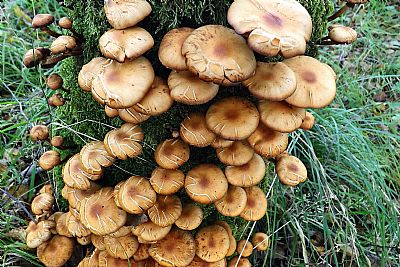SULPHUR TUFT MUSHROOM : Hypholoma fasciculare
Also known as clustered woodlover.
POISONOUS.
Compare this to the similar looking HONEY MUSHROOM
It looks very much like a honey mushroom, but its cap is more rounded.
Variations in colour may occur and it may be split. Splitting may be because of infection or interuptions in its growing progress due to a lack of moisture.
This mushroom grows prolifically in clumps on stumps, dead roots or rotting trunks of broadleaved trees. As Wiki warns : The "sulphur tuft" is bitter and poisonous; consuming it can cause vomiting, diarrhea and convulsions. The principal toxin is a steroid known as fasciculol E.
The toxicity of sulfur tuft mushrooms has been attributed, at least partially, to the toxic steroids fasciculol E and fasciculol F. In humans, symptoms may be delayed for 5–10 hours after consumption, after which time there may be diarrhea, nausea, vomiting, proteinuria and collapse. Paralysis and impaired vision have been recorded. Symptoms generally resolve over a few days. The autopsy of one fatality revealed fulminant hepatitis reminiscent of amatoxin poisoning, along with involvement of kidneys and myocardium. The mushroom was consumed in a dish with other species so the death cannot be attributed to sulfur tuft with certainty.
Hypholoma fasciculare has been used successfully as an experimental treatment to competitively displace a common fungal disease of conifers, Armillaria root rot, from managed coniferous forests.

A tree stump full of mushrooms. Almost all of these have split caps, most probably due to an interuption in the growth due to less moisture for a while. These are in the woods next to the Carman Reservoir in October.
WIKIPEDIA : https://en.wikipedia.org/wiki/Hypholoma_fasciculare
WILDFOOD : https://www.wildfooduk.com/mushroom-guide/sulphur-tuft/

